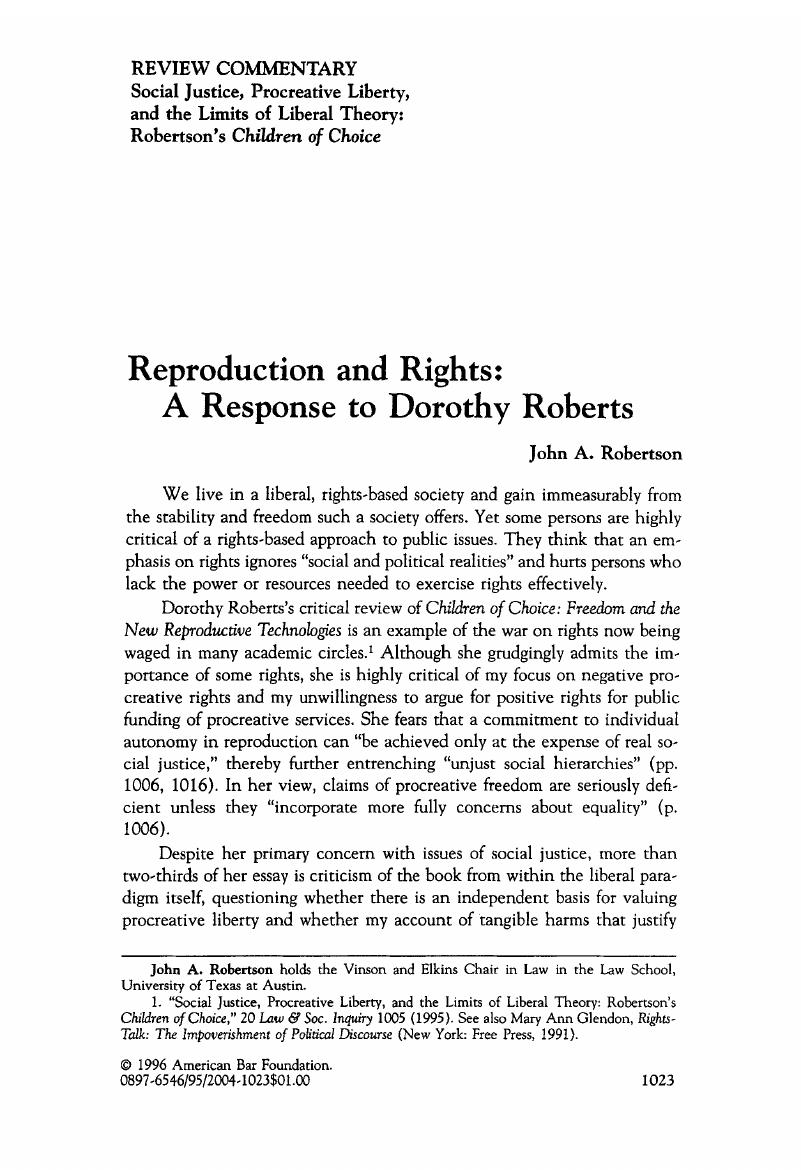No CrossRef data available.
Article contents
Reproduction and Rights: A Response to Dorothy Roberts
Published online by Cambridge University Press: 27 December 2018
Abstract

- Type
- Review Essay
- Information
- Copyright
- Copyright © American Bar Foundation, 1995
References
1 “Social Justice, Procreative Liberty, and the Limits of Liberal Theory: Robertson's Children of Choice,” 20 Law & Soc. Inquiry 1005 (1995). See also Mary Ann Glendon, Rights-Talk: The Impoverishment of Political Discourse (New York: Free Press, 1991).CrossRefGoogle Scholar
2 This is true both of technologies to avoid reproduction through new methods of contraception, abortion, and genetic screening, and technologies to achieve reproduction, such as IVF, the collaboration of donors and surrogates, and some forms of genetic engineering.Google Scholar
3 See, e.g., Griswold v. Connecticut, 381 US. 479 (1965).Google Scholar
4 Margaret Jane Radin, “Market-Inalienablility,” 100 Harv. L. Rev. 1849 (1987).CrossRefGoogle Scholar
5 John Robertson, “Posthumous Reproduction,” 69 Ind. L.J. 1027 (1994).Google Scholar
6 For example, gestational surrogacy enables a woman who has had a hysterectomy due to cancer still to have and rear genetic offspring. The fact that a third party gestates her and her partner's embryo does not lessen the reproductive nature or importance of the arrangement for the couple.Google Scholar
7 The criticism just discussed in part I may also be viewed as claiming that symbolic harms are important because they are just as subjective as my valuation of procreative liberty.Google Scholar
8 See, e.g., John Robertson, “Liberalism and the Limits of Procreative Liberty,” 52 Wash. & Lee L. Rev. 233, 255–58 (1995).Google Scholar
9 See Mathews v. Eldridge, 425 US. 319 (1976), for a conceptual paradigm of the questions to be asked and how they might be balanced.Google Scholar
10 The list of evils committed in the name of protecting “social and political relationships” is a long one, as the long fight to have classifications based on race brought under strict scrutiny shows. See, e.g., the use of a theory of social relations to uphold the separate but equal doctrine in Plessy v. Ferguson, 167 US. 537 (1896).Google Scholar
11 They may not understand their position as such, but when one strips away the various arguments, at bottom one finds a valuation of the importance of gestation that is close to a deontological or symbolic concern. See Radin, 100 Harv. L. Rev. 1828-37; Martha Field, “Surrogacy Contracts—Gestational and Traditional: The Argument for Nonenforcement,” 31 Washburn L. Rev. 433 (1992).Google Scholar
12 The paradigm case for this proposition is Griswold v. Connecticut, 381 U.S. 479 (1965).Google Scholar
13 I support policies to assure that donors, surrogates, and recipients make fully informed and free decisions about gamete donation and surrogacy. See Children of Choice at 136–42.Google Scholar
14 Roberts claims that my recognition of gender discrimination in the enforcement of rules of prenatal conduct shows that I recognize the importance of social and political factors when convenient. Her claim, however, overlooks the distinction between discussions of rights and discussions of policy. Broad speculations about the ultimate effect of a practice on society and gender relations may not be sufficient to justify limitations on the exercise of fundamental reproductive rights. But they may well be relevant in determining whether a punitive or nonpunitive approach should drive public policy.Google Scholar
15 See chap. 4. Roberts (p. 1013), however, is unhappy because I focus my analysis on the crucial philosophical question of whether birth in such circumstances harms those children and do not call for better social programs to prevent the conditions of concern.Google Scholar
16 Two excellent unpublished papers by Dan Brock present such a theory. See generally Dan Brock, “Funding New Reproductive Technologies: Should They Be included in a Basic Benefit Package?”in Cynthia Cohen, ed., Oocyte Donation: Ethical and Policy Issues (forthcoming 1996); id., “Reproductive Freedom: its Nature, Basis, and Limits” (Brown University, n.d.) (unpub. MS., on file with author).Google Scholar
17 Joan Callahan makes the same error in Book Review: “Procreative Liberty: Whose Procreation? Whose Liberty?” 6 Stan. L. & Pol'y Rev. 121, 122 (1995).Google Scholar
18 A single man may in a narrow theoretical sense have a right to hire a surrogate to have his child, but IVF programs and surrogate agencies would be within their rights not to participate in such transactions, because the child would lack a mother.Google Scholar
19 For an earlier version of an attempt to make this argument, see Barbara Kritchevsky, “The Unmarried Woman's Right to Artificial Insemination: A Call for Expanded Definition of the Family,” 4 Harv. Women's L.J. 1 (1981).Google Scholar
20 See Roberts, p. 1008, where she states that her disagreement with my rights approach might be compared with the proverbial dispute about whether a glass is half full or half empty.Google Scholar




